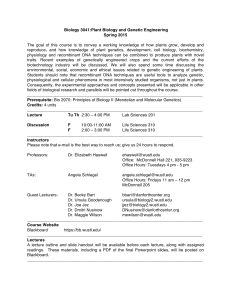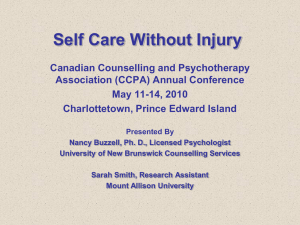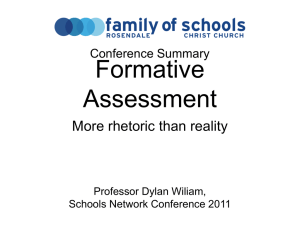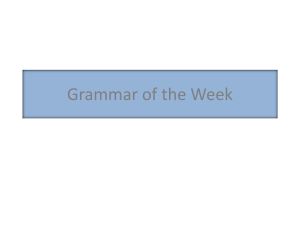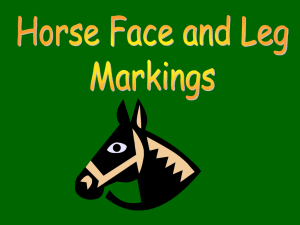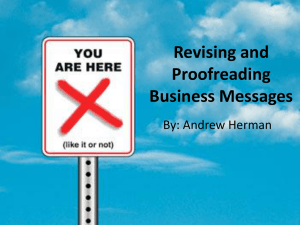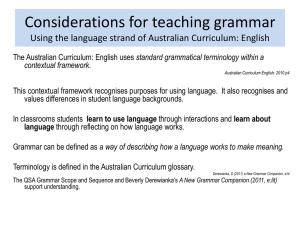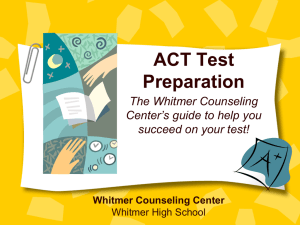Powerpoint on Proofreading Strategies
advertisement
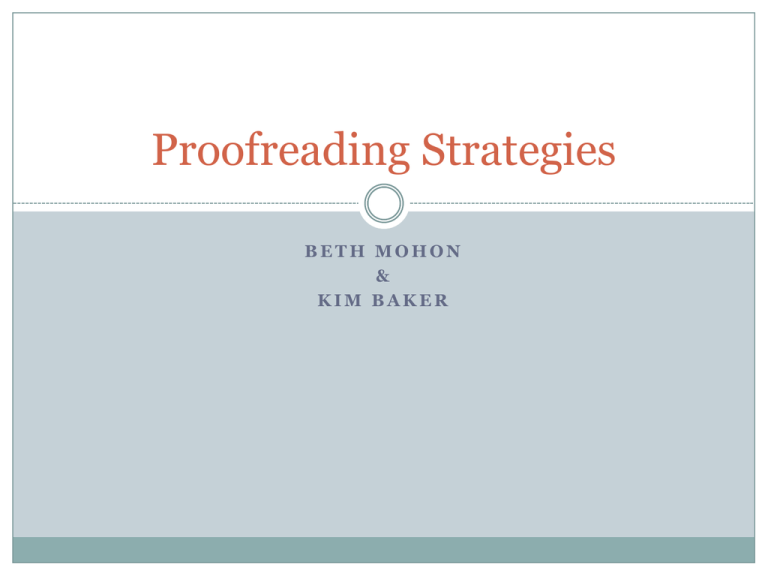
Proofreading Strategies BETH MOHON & KIM BAKER How do I teach my students to proofread by themselves? Outline Why we chose this method What you’ll need to prepare Minimal Marking Error Logs Handouts Why we chose this method We are advocating this method because we feel it will promote involvement of individual students in the proofreading/editing stage of their work and may hold students’ attention longer than a lecture. Many students are already writing their papers on the computer, so the use of technology in this lesson plan may make proofreading appear more relevant to them. • (This method is just one of many possible ways to approach the task of student revision processes.) Things you’ll need to do to prepare: Instructor Student Review your student’s Students must be told drafts and decide which issues you most want to focus on for this activity. Use minimal marking to bring errors to students’ attention. ahead of time to bring in an electronic version of their paper draft. They must also be aware of any classroom changes you may have to make. Things you’ll need to do to prepare: Instructor Before reserving the lab, consider: Talk to someone in the English department or the library about reserving a computer lab. When will be the best day in the class schedule to go? What drafting stage must the students be in to do this activity? How much time am I willing to put into this activity to tailor it to my students’ needs? Things you’ll need to do to prepare: Instructor Additionally, you may want to put the handouts associated with this activity on Blackboard before the students come to class, so that they can print them. You also may want to require a homework grade for bringing the electronic copy of their essay. Minimal Marking WHAT IS IT AND HOW DO YOU DO IT? Richard H. Haswell “Minimal Marking” (1983) Haswell is responding to Knoblauch and Brannon’s research (1981) which claims teacher’s written corrections are ineffective in improving students’ grammar. Knoblauch and Brannon propose that effective pedagogy “1) facilitates rather than judges, 2) emphasizes performance rather than finished product, 3) provides double feedback, before and after revision, and 4) helps bridge successive drafts by requiring immediate revision” (600). The benefits Haswell’s method Allows students idendepence to correct errors on their own Ensures that students will not be overburdened by exhaustive comments Saves instructors time and torment from writing exhaustive comments How Haswell does it Haswell’s classroom procedure follows this pattern: Notes grammar errors with a check in the margin of a student’s paper (nothing is written within the student’s text) Two checks in the margin indicates two errors within the text of the paper, three checks … and so on Haswell returns papers to students at the end of class and allows them to attempt to correct these errors He offers help and explanations through subsequent comments and only grades papers after students have attempted to correct their own errors How we’re different With this method, Haswell reports that students can correct 60-70% of their own errors with minimal prompting. Lisman also finds that 60% of errors are corrected by her “least capable students” (Haswell 601). An important difference between Haswell’s method and what we have planned is that we intend to list for students at the top of the page the different varieties of errors that we found. We are also introducing grammar rules immediately into the classroom in conjunction with students reviewing our minimal marks. Haswell notes after explaining the benefits of his method that he does periodically lecture about grammar rules throughout the semester. So this technique is not quite the miracle sans instruction that some may initially perceive it as. Nice chart about how minimal marking works! Over the course of a freshman comp class, the drop was from 4.6 errors per 100 words to 2.2 (52%). More about errors Students typically correct all varieties of errors at the same rate. Grammar mistakes, in Haswell’s estimation, generally constitute “threshold errors, standing on the edge of competence in an unstable posture of disjunction (‘I know it is either conceive or concieve’) or of half-discarded fossilization (‘I don't know why I capitalized “Fraternities.” I know that's wrong.’) (602). Further, errors “mark stages,” in David Bartholomae's words, “on route to mastery” (qtd. in Haswell 602). Students have already learned grammar rules. They need to solidify that knowledge and feel that they are capable to apply it. Let’s take a break from the PowerPoint to look at our handouts. Error Logs WHAT ARE THEY AND HOW DO THEY FUNCTION? Error Logs Referencing Jane Cogie’s “Avoiding the Proofreading Trap: The Value of the Error Correction Process.” Note this essay focuses working in Writing Centers with ESL students. The main goal of this work is to make ESL students more independent. This goal also coincides with our thoughts on the process of proofreading and editing. For these practices to be successful and helpful to the student, the student must take responisbility for locating and correcting their work. Time Like minimal marking, keeping and maintiaining an error log takes time on the part of the instructor and the student. However, as Cogie states “once the [instructor] has introduced these strategies and guided the . . . Student through their application, the student should be able to begin to practice to use them independently.” (19) What Goes in an Error Log? The error log we have created asks the student to record the type of error, the rule associated with that error, the full sentence in which the errror occurs, and the corrected sentence. Cogie notes that it’s important to include the full sentence in which the error occures “. . .to provide a clear context for the target feature and promote rule acquisition. . .” (19) The rule should be recorded because “the more students know about the rules of grammar, the easier it will be for them to cover more types of errors and make progress in learning to self edit.” (12) Does it work? Cogie referenced one student in her Writing Center who, after using an error log “. . .was able to see the pattern of her most significant problems. Although her writing did not become error-free, the number of errors was reduced significantly, by an estimated 35%.” (20) So yes, but… They have to be used! Error logs can’t work if they aren’t used and maintained. We are suggesting an activity for a paper dealing with error logs, but to be the most helpful this must be a project that is maintained throughout the course. In other words, don’t just use it for paper 2, but also paper 3 and paper 4. This way students have more exposure to the log as they continue to update it. Haswell also emphasizes that for minimal marking to work, it should be maintained over the course of a semester. Remember… As Cogie says “. . .the ultimate goal for our students is not error-free drafts . . .but rather the ability to edit their own work.” (20) The key word with this activity is “independence”. Follow ups activities WHAT CAN YOU DO AFTER THIS? Reflection After students have completed the grammar workshop and in particular the style workshop ask them to reflect. What do they learn about their writing through this activity? What did they learn by comparing their sentence structures to their classmates? – to professional writers? How to continue with the error log In her essay, Cogie mentions an activity that students who are more aware of the types of errors they make can participate in. She suggests having students list the three most frequent erros they make that deserve priority. (21) These issues would be the ones the student focuses on for that particular piece. Instructors may want to add their own ideas about which error is most prevelant in the student’s work. References Cogie, Jane and Kim Strain and Sharon Lorinskas. “Avoiding the Proofreading Trap: The Value of the Error Correction Process.” The Writing Center Journal 19.2 (1999): 7-31. Haswell, Richard H. “Minimal Marking.” College English 45.6 (1983): 600-604. The Purdue Online Writing Lab. 2008. The Writing Lab, The OWL at Purdue, the English Department, and Purdue University. 29 Sept 2009. <http://owl.english.purdue.edu/>.
